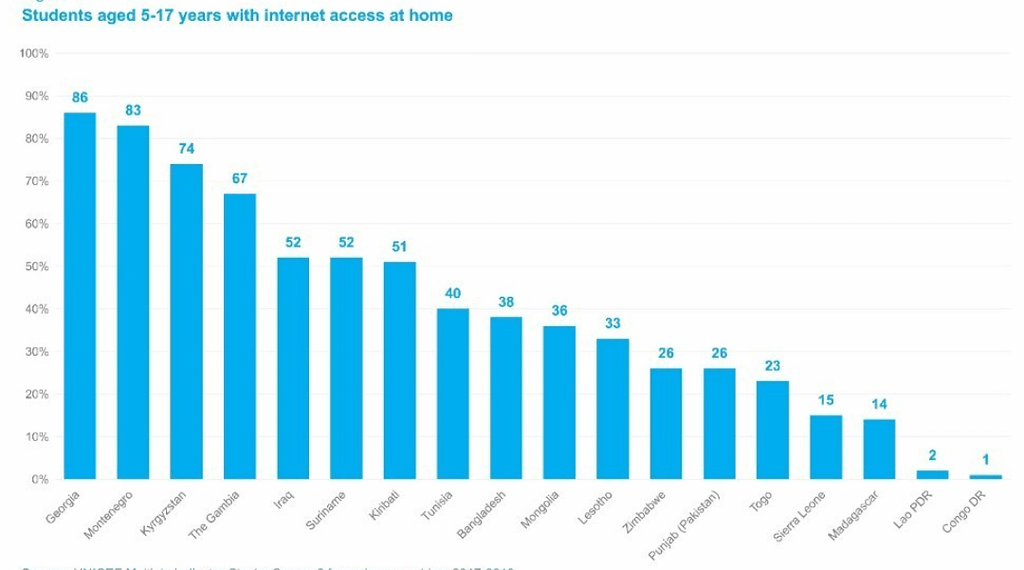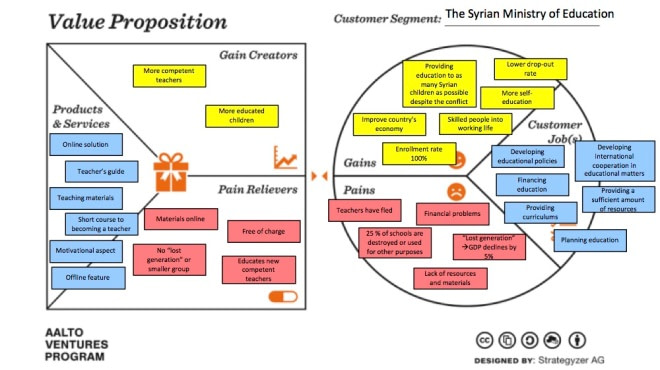You decided to launch your EdTech startup. Let’s admit it the EdTech market is a very promising niche now amid pandemic.
- The global EdTech market size was valued at USD 89.49 billion in 2020 and is expected to reach USD 106.04 billion in 2021 (Source)
- In the first half of May 2020, demand for online educational courses was up 250% from the year before (Source).
Let’s figure out how to get the project started while achieving success with driving the first customers.
First thing to do here is to form hypotheses.
Defining the target audience and problems
To build a product promotion strategy, you need to study the pains and gains of the target audience. Then only you will be able to convey to users how your product will solve their problems.
Every commercial project should start with answers to two questions:
- who is our audience and
- what problem you are solving for them.
A hypothesis consists of three things.
1 What’s happening
You should answer the question: “How can the background affect your project?”
The quarantine period is still our reality and the transition to distance learning is just what an EdTech project needs.
2 What problem do we solve and for whom
You should know what the audience needs and what it is not satisfied with, especially in the context of edtech product development. Then determine who might be looking for the solutions you provide.
Suppose that parents are afraid for their children’s high school enrollment and academic performance. That is the problem.
Then, let’s define the geographic distribution of your edtech service. Not in all countries the education system is ready for distance learning.
There are 8 countries that are leading in in online education:
- United States
- India
- China
- South Korea
- Malaysia
- United Kingdom
- Australia
- South Africa
Other countries have different opportunities for Internet access:

You need to consider this before launching your ad campaign to target only those of your audience who are more likely to order from you.
3 How can we help fix this
Here you should understand what disadvantages your competitors have and formulate your own value hypothesis. Then test the hypothesis, and if it is correct, get to work.
Nowadays, the EdTech market evidences a lack of resources to find a tutor, independent interactive training or group classes. Another insight is that group lessons are not effective enough. As for interactive learning – elementary school students are not diligent enough to learn on their own.
So, you can assume that the school would be able to satisfy the pain of the parents, as it offers one-to-one lessons and is responsible for the child’s progress.
The main thing is not to get stuck at the hypothesis stage
It may turn out that the assumptions do not have anything to do with reality. Therefore, it is important to check it as quickly as possible with your target audience: whether the product will be in demand and what objections customers may have.
To find it out, launch a Facebook Ads campaign and start testing the hypothesis while selling. Call customers and listen to their complaints. If you neglect communication with the target audience about their problems, then there is a risk of missing pains that can be used to product improvements.
Making your first sales, refine your offer. If people have a problem that they write about in social media, it is easy to guess that there are many companies offering similar solutions. But speaking about the EdTech market, the demand exceeds the offer. And if you do something a little better and faster – for example, you know how to select teachers, then the probability to get money is going up.
People worry that it is difficult to find a good teacher at an affordable price. Parents have no time, desire, or understanding of the subject to help children. Your EdTech project should solve this problem: help in finding a tutor with a guarantee of the result and the ability to track a child’s progress.
With the hypotheses and problems of the target audience, it becomes clearer. Now it’s time to form your value proposition.
Defining a value proposition
A formulated value proposition helps the team focus on the main things. Employees understand what they are working on and what they are selling. Customers better understand what they are paying for. For a value proposition to work, you need to constantly analyze the market and customers.
To define a value proposition, you can build Value Proposition Canvas. It is divided into two areas. See the figure below. The right section shows the characteristics of users explaining why they use a product. It consists of three parts: pains, objectives and benefits. On the left, there are solutions that meet the needs of users. These are products and services, help factors and benefits.

The unique value of a project in the field of EdTech can be
1. The ability not only to find a tutor, but providing the quality assurance and the ability to monitor the progress.
For example, if the client is not satisfied with the result, the school can offer another teacher or refund the money. This is where the one-seller store works better rather than a marketplace model as you’re only in charge of the service quality.
2. Instead of interactive content for self-study, you can lead a student by the hand.
Training should be optimal for the pace of learning and ability to master new things with your customer.
3. Your e-school can offer individual training.
In the EdTech field, the first acquaintance with the product is usually free of charge with the majority of competitors. For example, Udemy offers two weekly trial options.
If you don’t have enough money to conduct free lessons, determine how much value to invest in the first lesson in order to ignite interest with your customers. Your proposal must be clear and the result should be obvious. For example, you can offer a mini-product “Testing math knowledge for your child”. Parents will see its clear benefit: an assessment of gaps and a detailed training plan.
Competitor analysis
If you do not analyze your competitors, you will not be able to understand what are the minimum functions your product should have to enter the market and stand out from the rest of the market players.
To do this, you can use points of parity and points of difference.
Points of parity (POP) is a basic set of product features present in all similar offers at your market. POP is designed to clearly define the user’s expectations in order not to fall behind them.
Points of difference (POD) is what makes a product different from the rest. POD gives you the understanding of what people value the product for, why they continue to pay for it and what they expect in the future. If there is no clear difference, then it should be created by testing several PODs.
POP and POD products in the online education market
The online learning market is structured as follows:
- Individual tutors : unique teaching method
- Marketplaces: the ability to find lessons under optimal conditions
- Schools: guarantee of result and an opportunity to replace the teacher
POP for all three comes down to the service of a tutor who remotely helps children with their studies. They differ in service, guarantees, price, and the platform.
Individual tutors often provide quality knowledge at an adequate cost, but do not take upon themselves the solution of problems related to the organization of the lesson and communications with a student. They also use a simple stack, which often consists of Zoom and interactive whiteboard. However, they do not give any guarantees and may disappear in any moment.
Marketplaces solve the problem of choice. This is the option in which the user gets the optimal cost of a teacher per hour. There is high competition here. But parents cannot be sure that they can get the money back if the tutor doesn’t fit them.
The advantage of the school is that it provides not only a tutor, but also a service. Parents have not just simple testing of gaps, but an individual training plan and result guarantee.
Let’s say our EdTech project works in the “school” niche, since this format really helps to solve the user’s problem. The absence of a free lesson here can be turned into a point of difference. It is useful not only to scan information about competitors, but also to test their products yourself. This will highlight the advantages and disadvantages that can be used to improve the product.
For example, Coursera’s educational course has distinctive advantages: free access to the text transcript of the lecture, the opportunity to take the course for free and view lectures in their mobile application. However, Coursera does not provide free certificates of course completion and does not allow downloading lectures.
Having studied the market and competitors, you can begin to determine the price.
Price determination
The price should match the market average, and allow the unit economy to converge. If it turns out to be unsuitable, then there is a risk of not recouping the costs.
How to price an EdTech product:
- Launch the audience poll to know how much parents spend on their kids’ extracurricular activities
- Conduct pricing market research: to know how much competitors offer for similar services
- Conduct market analysis: to know how much to pay employees
- Lead cost hypothesis: to know how much a lead cost
Price testing
If you do not check the price regularly, it may turn out that the business is “leaving money on the table ”. Namely, it misses the benefit.
An increase in the price of a product does not guarantee an increase in profits and revenues. As a result of experiments with the price, you can come to the conclusion that it is more profitable to sell cheaper, but more.
Let’s examine the cost testing done by Twitter. The social network launched their Twitter Blue subscription for $ 2.99. And depending on how the audience reacts to it, Twitter changed the cost and the set of options.
There are two ways to test the price:
- The first is to segment leads and see how they react to price changes. If sales fall after the price rises, the price will have to return.
- The second way is A / B testing – when you send a modified page with your offer to half of your audience, and the other gets the original proposal. Based on test results, one can conclude which of them has a higher conversion.
Building infrastructure
When starting an EdTech development project, you should select tools according to the formula: “maximum flexibility for a minimum budget”. In other words, the tool should be able to do a lot, be cheap, preferably free of charge. Every additional subscription eats up the profits.
To determine the tools, it is useful to build the product architecture and think about what else should be connected to your one-seller’s store. Thereafter, define how to connect the chosen tools together. It can be integration via third party services or an API integration.
For example, for an EdTech project you may need:
- eCommerce platform to sell your educational product and process payments
- EdTech CRM system for communicating with clients and employees, and connecting telephony.
- Video conferencing software like Zoom.
With the tools chosen, it’s time to think about traffic.
Driving first traffic
A traffic acquisition channel may work great for one project, but be useless to another. Therefore, when choosing channels, you should be guided by your market background, target audience, and price category:
- If you are promoting a B2B product, you shouldn’t opt for Facebook ads as the main promotion channel. The audience is small and quickly depleted. Perhaps in this case, email distribution and calling companies will work better.
- SEO will not perform well for mobile app promotion, because they are more often searched for in app stores like the Play Market. Maybe, it is worth focusing on the app store optimization.
- There is no point in promoting your online store through maps like Google Maps. Most likely, users are looking for you through search engines. The contextual advertising will be a good choice here.
Attracting leads
Direct communication with potential buyers helps you find out what they want. To increase conversion, you need to understand:
- What objections the client has (maybe, price or service composition)?
- Why do they bounce (the reason of not closing a deal)?
- What insights from the conversion rate you can glean?
First sales
It’s not enough to learn how to acquire leads. It is also worth thinking about how to make them pay.
People may not want to buy from you for a variety of reasons. For example, they may feel uncomfortable to enter their credit card details on an unfamiliar site.
It is important to remove customer friction here by offering a convenient payment system with two-factor authentication for more security. This opportunity is present in Google and Apple Pay. It offers additional verification with 3D Secure (authentication using bank login credentials).
Closing
You shouldn’t be afraid to go into a wide niche. If business succeeds slightly better than competitors, then a chance to increase your revenue goes up significantly. The main thing to do is to analyze the market and offer a unique product/service. And to sell your unique educational product, you need a platform. The default CS-Cart can be modified for an EdTech project. Simtech Development can help you implement necessary customizations, ensure reliable and safe hosting of your project and offer the best quality of service.

